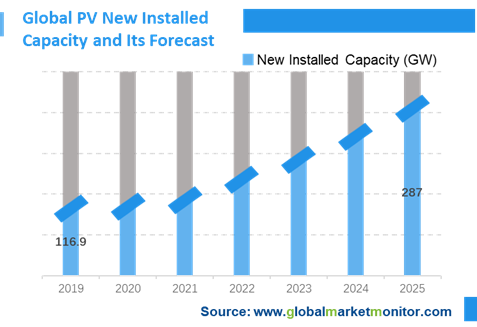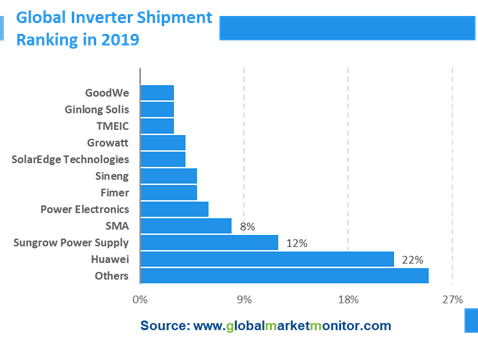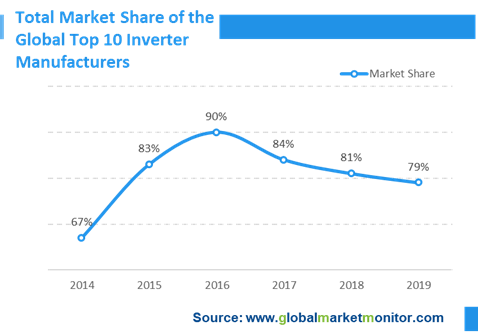In the photovoltaic power generation system, the inverter which accounts for a small proportion of the cost, has a direct impact on the stability of the system's power generation, the effect of the launch point, and the life span,which is responsible for the conversion of DC to AC, and together with components, combiner boxes, and cables, and brackets to constitute the entire photovoltaic system, and is also the only intelligent device in the photovoltaic system. The inverter has functions such as maximum power point tracking and islanding effect protection, and has always been the focus of investors and installers.
As a renewable and green new energy source, solar energy has become a new driving force for the development of countries all over the world. The newly installed photovoltaic capacity in 2019 was 116.9GW, a year-on-year increase of 24.4%. With the sound development of the global photovoltaic industry, it is estimated that the newly installed photovoltaic capacity will reach 287GW in 2025, with a compound annual growth rate of 16%.

It Is Estimated Inverter Shipments Of 300GW in 2025
Benefiting from the vigorous development of distributed systems and heavy replacement demand, the inverter market is expected to reach US$18 billion in 2025. Data show that in 2019, global inverter shipments reached 126.7GW, an increase of 18% year-on-year, and revenue reached US$8.59 billion, an increase of 15.5% year-on-year. With the vigorous development of household photovoltaics and the continuous increase in replacement demand, it is estimated that the global inverter market space will reach 300GW by 2025, corresponding to US$18 billion in revenue, and the prospect is broad.
Among them, the global inverter replacement demand can reach 45GW in 2025. Different from the service life of about 25-30 years of photovoltaic modules, the service life of photovoltaic inverters is generally about 10 years, which means that the inverter products need to be replaced at least once during the operation cycle of the photovoltaic power station. The global photovoltaic market has entered the fast lane of commercialization since 2001. Over time, the market demand for inverter replacement has gradually emerged. The data shows that as of 2020Q1, the number of photovoltaic inverters that need to be replaced reaches 21GW. According to the new regulations on the capacity ratio released by the industry in 2019, assuming that the capacity ratio is 1.12 domestically and 1.35 overseas, it is conservatively estimated that the global inverter replacement demand in 2025 will reach 45GW.
Enquire before purchasing this report-
https://www.globalmarketmonitor.com/reports/589789-solar-cells-and-modules-market-report.html
According to application scenarios, inverters can be divided into centralized inverters, tandem inverters, and distributed inverters, and micro-inverters. Centralized inverters are used in large-scale ground power stations, and the output power is usually above 500KW; for tandem inverters, an inverter is installed on each photovoltaic tandem to complete MPPT tracking; the characteristic of the decentralized MPPT tracking in the tandem; the micro-inverter has the maximum power point tracking at the component level, and the power is less than or equal to 1kW. The traditional inverter is to connect all the DC power in series and parallel, and convert it into AC power through the inverter to connect to the grid, while the micro-inverter inverts each component.
Tandem Inverters Will Still Be the Mainstream Market in the Next Few Years
Due to technological iterations and changes in demand, the market has shifted from large ground power stations to distributed photovoltaics. Related reports show that in 2017, the shipment of tandem inverters exceeded that of centralized inverters for the first time, with a scale of about 4GW. With the rise of distributed photovoltaics in various countries in 2018, in addition to India, markets such as China, the United States, and Australia are the strategic points of tandem inverters. As the government and owners pay more attention to safety, tandem inverters will remain the mainstream of the market in the future. However, in order to meet the needs of the market, it is more likely to be transformed or upgraded on the basis of the tandem type.

Huawei, Sungrow Power Supply, And SMA Rank Among the Top Three in Inverter Shipments
Global inverter shipments in 2019 were 126.7GW, of which China's total inverter output was 73.5WG. Huawei, Sungrow Power Supply, and SMA occupy the top three in inverter shipments due to their absolute advantages in their respective fields.

Inverter Manufacturers Lock in Different Subdivisions, And Industry Concentration Is Decreasing Year by Year
The old German inverter manufacturer SMA focuses on high-power inverters, and its products are widely used in large ground power stations. SolarEdge and Enphase focus on the U.S. household market, with a market share of 80%, focusing on micro-inverters and power optimizers. Ginlong Solis focuses on tandem inverters, which is the leader in subdivision circuits below 20kW. Huawei mainly promotes tandem inverters, which can cover a minimum power of 3kW. Sungrow Power Supply focuses on centralized inverters above 500kW. The Industry concentration has shown a decentralized trend since 2016, and the market share of the top five photovoltaic inverter giants has gradually decreased. According to the data, the CR10 of the global photovoltaic inverter market in 2019 was 79%, which was 12% lower than the CR10 in the 2016 market.

It can be seen that competition in the photovoltaic inverter market has become increasingly fierce, in which new entrants and other manufacturers continue to carve up the market occupied by leading companies. Due to the price pressure of market segments and input-output efficiency factors, foreign non-main inverter companies have gradually withdrawn from the market. We believe that with the optimization of the industry's competitive landscape in the future, the advantages of large-scale costs will become prominent in the future, and industry concentration is expected to further increase.
LEARN MORE:
Solar Cells and Modules
https://www.globalmarketmonitor.com/reports/589789-solar-cells-and-modules-market-report.html
Solar Photovoltaic
https://www.globalmarketmonitor.com/reports/406047-solar-photovoltaic-market-report.html
We provide more professional and intelligent market reports to complement your business decisions.